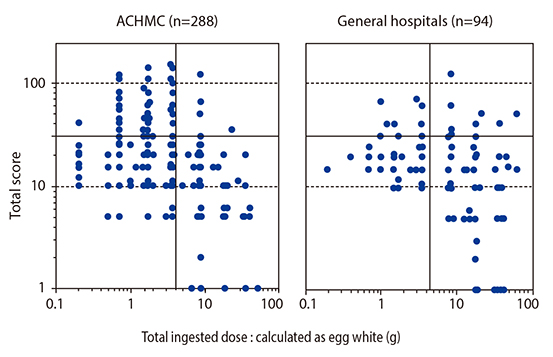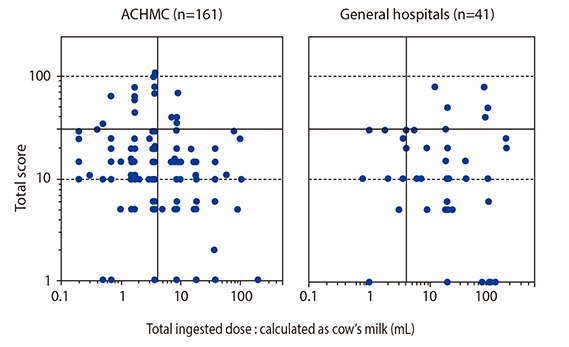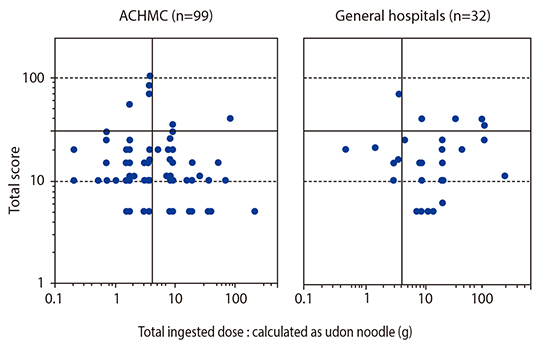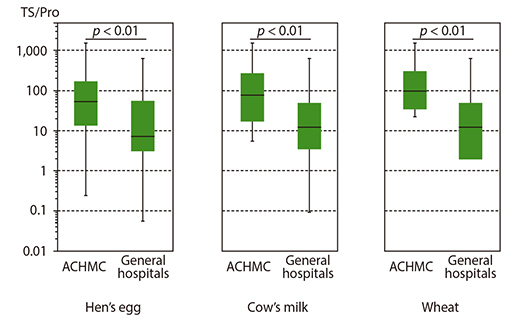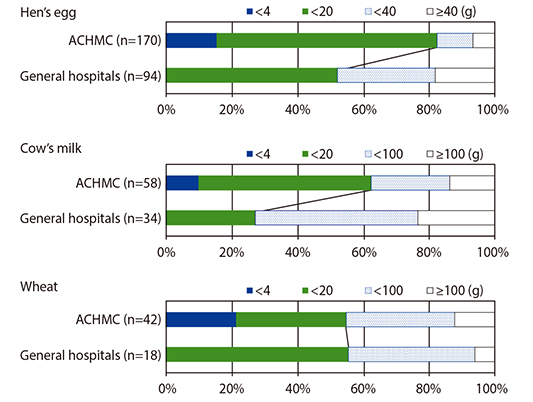Asia Pac Allergy.
2017 Oct;7(4):234-242. 10.5415/apallergy.2017.7.4.234.
Evaluation of the results of oral food challenges conducted in specialized and general hospitals
- Affiliations
-
- 1Department of Allergy, Aichi Children's Health and Medical Center, Obu 474-8710, Japan. koumei_itoh@mx.achmc.pref.aichi.jp
- 2Department of Pediatrics, Okazaki City Hospital, Okazaki 444-8553, Japan.
- 3Department of Pediatrics, Kasugai Municipal Hospital, Kasugai 486-8510, Japan.
- 4Department of Pediatrics, Tosei General Hospital, Seto 489-8642, Japan.
- 5Department of Pediatrics, Toyota Kosei Hospital, Toyota 470-0396, Japan.
- KMID: 2410218
- DOI: http://doi.org/10.5415/apallergy.2017.7.4.234
Abstract
- BACKGROUND
Oral food challenge (OFC) tests are conducted in both specialized institutions and general hospitals. We aimed to compare the severity of the conditions of the patients between these 2 types of institutions in order to consider the role of such institutions in society.
OBJECTIVE
We evaluated the results of OFC tests for hen's egg, cow's milk, and wheat that were conducted in a specialized institution (Aichi Children's Health and Medical Center [ACHMC], n = 835) and in 4 general hospitals (n = 327) in Aichi prefecture, Japan.
METHODS
The symptoms provoked were scored using the total score (TS) of the Anaphylaxis Scoring Aichi scoring system in combination with the total ingested protein dose (Pro) before the appearance of allergic symptoms.
RESULTS
The total ingested dose of the challenge-positive patients in ACHMC was significantly less than that in the general hospitals (p < 0.01). The median TS of the provoked symptoms in ACHMC and the general hospitals did not differ to a statistically significant extent in the hen's egg or cow's milk challenges; however, the median TS in ACHMC was significantly lower than that in the general hospitals for the wheat challenge (p = 0.02). The median TS/Pro values in ACHMC were almost identical to the upper 25% of the TS/Pro values in the general hospitals, suggesting that the specialized institution usually managed more severe patients.
CONCLUSION
The specialized institution performed OFC tests at a lower threshold dose, but provoked similar TSs to the general hospitals. This evaluation may help in optimizing the distribution of patients to general hospitals and specialized institutions.
Keyword
MeSH Terms
Figure
Cited by 1 articles
-
Autumn leaves: about aging and allergy
Yoon-Seok Chang
Asia Pac Allergy. 2017;7(4):183-184. doi: 10.5415/apallergy.2017.7.4.183.
Reference
-
1. Muraro A, Werfel T, Hoffmann-Sommergruber K, Roberts G, Beyer K, Bindslev-Jensen C, Cardona V, Dubois A, duToit G, Eigenmann P, Fernandez Rivas M, Halken S, Hickstein L, Høst A, Knol E, Lack G, Marchisotto MJ, Niggemann B, Nwaru BI, Papadopoulos NG, Poulsen LK, Santos AF, Skypala I, Schoepfer A, Van Ree R, Venter C, Worm M, Vlieg-Boerstra B, Panesar S, de Silva D, Soares-Weiser K, Sheikh A, Ballmer-Weber BK, Nilsson C, de Jong NW, Akdis CA. EAACI Food Allergy and Anaphylaxis Guidelines Group. EAACI food allergy and anaphylaxis guidelines: diagnosis and management of food allergy. Allergy. 2014; 69:1008–1025.
Article2. Boyce JA, Assa'ad A, Burks AW, Jones SM, Sampson HA, Wood RA, Plaut M, Cooper SF, Fenton MJ, Arshad SH, Bahna SL, Beck LA, Byrd-Bredbenner C, Camargo CA Jr, Eichenfield L, Furuta GT, Hanifin JM, Jones C, Kraft M, Levy BD, Lieberman P, Luccioli S, McCall KM, Schneider LC, Simon RA, Simons FE, Teach SJ, Yawn BP, Schwaninger JM. NIAID-Sponsored Expert Panel. Guidelines for the diagnosis and management of food allergy in the United States: summary of the NIAID-sponsored expert panel report. J Allergy Clin Immunol. 2010; 126:1105–1118.
Article3. Ebisawa M, Ito K, Fujisawa T. Committee for Japanese Pediatric Guideline for Food Allergy, The Japanese Society of Pediatric Allergy and Clinical Immunology, The Japanese Society of Allergology. Japanese guidelines for food allergy 2017. Allergol Int. 2017; 66:248–264.
Article4. Yanagida N, Okada Y, Sato S, Ebisawa M. New approach for food allergy management using low-dose oral food challenges and low-dose oral immunotherapies. Allergol Int. 2016; 65:135–140.
Article5. Ebisawa M, Nishima S, Ohnishi H, Kondo N. Pediatric allergy and immunology in Japan. Pediatr Allergy Immunol. 2013; 24:704–714.
Article6. Nurmatov U, Dhami S, Arasi S, Pajno GB, Fernandez-Rivas M, Muraro A, Roberts G, Akdis C, Alvaro-Lozano M, Beyer K, Bindslev-Jensen C, Burks W, du Toit G, Ebisawa M, Eigenmann P, Knol E, Makela M, Nadeau KC, O'Mahony L, Papadopoulos N, Poulsen LK, Sackesen C, Sampson H, Santos AF, van Ree R, Timmermans F, Sheikh A. Allergen immunotherapy for IgE-mediated food allergy: a systematic review and meta-analysis. Allergy. 2017; 72:1133–1147.
Article7. Savage JH, Matsui EC, Skripak JM, Wood RA. The natural history of egg allergy. J Allergy Clin Immunol. 2007; 120:1413–1417.
Article8. Skripak JM, Matsui EC, Mudd K, Wood RA. The natural history of IgE-mediated cow's milk allergy. J Allergy Clin Immunol. 2007; 120:1172–1177.
Article9. Keet CA, Matsui EC, Dhillon G, Lenehan P, Paterakis M, Wood RA. The natural history of wheat allergy. Ann Allergy Asthma Immunol. 2009; 102:410–415.
Article10. Hino A, Maeda T, Haneda Y, Kobayashi T, Yasui M, Kando N, Ito K. Establishment of “Anaphylaxis Scoring Aichi (ASCA),” a new symptom scoring system to be used in an oral food challenge (OFC). Arerugi. 2013; 62:968–979.11. Urisu A, Ebisawa M, Ito K, Aihara Y, Ito S, Mayumi M, Kohno Y, Kondo N. Committee for Japanese Pediatric Guideline for Food Allergy, Japanese Society of Pediatric Allergy and Clinical Immunology. Japanese Society of Allergology. Japanese Guideline for Food Allergy 2014. Allergol Int. 2014; 63:399–419.
Article12. Sampson HA. Anaphylaxis and emergency treatment. Pediatrics. 2003; 111(6 Pt 3):1601–1608.
Article13. Sugiura S, Matsui T, Nakagawa T, Sasaki K, Nakata J, Kando N, Ito K. Development of a prediction model of severe reaction in boiled egg challenges. Allergol Int. 2016; 65:293–299.
Article14. Ministry of Education, Culture, Sports, Science and Technology. The standard tables of food composition. 7th ed. Tokyo: Ministry of Education, Culture, Sports, Science and Technology;2015.15. Kamioka N, Nomura T, Kato T, Yoneyama M, Sobajima T, Tanida H, Morishita T, Sugiura S, Suda Y, Hirabayashi Y, Misawa C, Tanaka H, Mizuno M, Terada A, Kanda Y, Saitoh S. Probability curves for predicting symptom severity during an oral food challenge with wheat. Allergol Int. 2017; 66:627–628.
Article16. Perry TT, Matsui EC, Conover-Walker MK, Wood RA. Risk of oral food challenges. J Allergy Clin Immunol. 2004; 114:1164–1168.
Article17. Ito K. Diagnosis of food allergies: the impact of oral food challenge testing. Asia Pac Allergy. 2013; 3:59–69.
Article18. Sampson HA, Gerth van Wijk R, Bindslev-Jensen C, Sicherer S, Teuber SS, Burks AW, Dubois AE, Beyer K, Eigenmann PA, Spergel JM, Werfel T, Chinchilli VM. Standardizing double-blind, placebo-controlled oral food challenges: American Academy of Allergy, Asthma & Immunology-European Academy of Allergy and Clinical Immunology PRACTALL consensus report. J Allergy Clin Immunol. 2012; 130:1260–1274.19. Yanagida N, Imai T, Sato S, Ebisawa M. Do longer intervals between challenges reduce the risk of adverse reactions in oral wheat challenges? PLoS One. 2015; 10:e0143717.
Article20. Okada Y, Yanagida N, Sato S, Ebisawa M. Better management of cow's milk allergy using a very low dose food challenge test: a retrospective study. Allergol Int. 2015; 64:272–276.
Article21. Okada Y, Yanagida N, Sato S, Ebisawa M. Better management of wheat allergy using a very low-dose food challenge: a retrospective study. Allergol Int. 2016; 65:82–87.
Article22. Masuko I. The role of allergy educator. Arerugi. 2012; 61:1054–1059.23. Turner PJ, Mehr S, Joshi P, Tan J, Wong M, Kakakios A, Campbell DE. Safety of food challenges to extensively heated egg in egg-allergic children: a prospective cohort study. Pediatr Allergy Immunol. 2013; 24:450–455.
Article24. Ebisawa M. Management of food allergy in Japan “food allergy management guideline 2008 (revision from 2005)” and “guidelines for the treatment of allergic diseases in schools”. Allergol Int. 2009; 58:475–483.
Article25. Ito K. Establishment of the oral food challenge network. Arerugi. 2012; 61:1047–1053.
- Full Text Links
- Actions
-
Cited
- CITED
-
- Close
- Share
- Similar articles
-
- Clinical application of histamine prick test for food challenge in atopic dermatitis
- Oral food challenges: result of a 16-year experience at a major teaching hospital in Thailand
- Crossover Food Businesses in Louisiana, United States: A Descriptive Study of Their Characteristics and Food Safety Training Needs From Public Health Inspectors’ Perspective
- Oral food challenges in children
- Patients' Evaluation on Foodservice in University and General Hospitals

